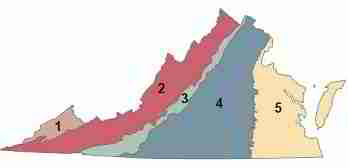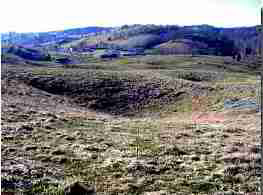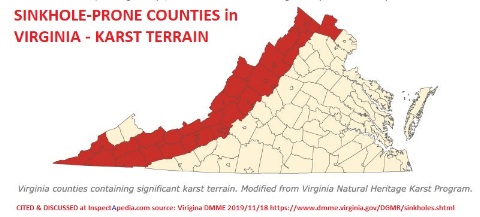 Sinkholes & Subsidences in Virginia
Sinkholes & Subsidences in Virginia
- POST a QUESTION or COMMENT about sinkholes and their effects on buildings
Sinkholes in Virginia.
This article describes the location & type of sinkholes occurring in Virginia.
This article series explains what sinkholes are and why they occur, describes their effects on buildings, and gives building and site inspection advice useful in identifying areas where there is an increased risk of sink holes at properties.
The photograph (above-left) of a sinkhole opening in a residential yard in Pennsylvania is from Kochanov, W.E. and illustrates the child hazard or even adult sinkhole hazard that can be formed by storm water drainage.
InspectAPedia tolerates no conflicts of interest. We have no relationship with advertisers, products, or services discussed at this website.
- Daniel Friedman, Publisher/Editor/Author - See WHO ARE WE?
Sinkholes in Virginia
The Virginia Department of Mines, Minerals, and Energy reports that sinkholes have been reported in that state since colonial times.
“In the spring of the year 1780, the earth at the bottom of this sink suddenly gave way and fell into the cavity below, forming a circular aperture about the ordinary circumference of a common artificial well . . .
There being no artificial or natural means to prevent the earth immediately about the well from falling in, the aperture is greatly enlarged, forming a sloping bank, by which a man on foot can easily descend within eight or ten feet of the water
.... The whole depth of the cavity is thirty or thirty-five feet” (Kercheval, 1850, p. 273).
As in several of the other locations of sinkholes around the U.S., Canada, and other countries, in Virginia sinkholes are associated with karst formations. The sinkhole photograph above (from Virginia's DMME) shows a sinkhole that formed in Russell County, Virginia. According to the DMME, [quoting]
In Virginia the formation and modification of sinkholes (also known as sinks, dolines and dolinas) is a natural process in areas underlain by limestone and other soluble rock. The location and rate at which sinkholes form can be affected by man’s activities.
Sinkholes are basin-like, funnel shaped, or vertical-sided depressions in the land surface. In general, sinkholes form by the subsidence of unconsolidated materials or soils into voids created by the dissolution of the underlying soluble bedrock.
The rock exposed in a collapsed sinkhole is usually weathered and rounded, but some sinkholes contain freshly broken rock along their steep sides. Freshly broken rock may indicate that the sinkhole has formed by the collapse of a cave (naturally occurring) or a mine (man-made).
Where sinkholes and caves have formed by the dissolution of soluble rock, such as limestone, dolomite, and gypsum, surface water is uncommon and streams may sink into the ground.
This type of topography, formed by dissolution, is referred to as karst terrain. In karst terrain, sinkholes are input points where surface water enters the groundwater system.
Also see WHAT IS KARST ?
Signs of sinkhole formation in Virginia
Although a sinkhole can form suddenly and without warning, this list, courtesy of the state's department of geology, lists several specific signs that can signal potential development:
- Slumping or falling fence posts
- Wilting vegetation
- Discolored well water
- Structural cracks in walls, floors, or foundations.
- Cracks in soil/subsidence.
Location of Sinkholes in Virginia
The VA DMME [and the Virginia Division of Geology and Mineral Resources within the DMME]provides the map showing the location of sinkholes by underlying cause and probability. Quoting:
Sinkholes are most prevalent in karst terrains, but they occur throughout Virginia. Areas which may contain sinkholes:
- Subsidence/sinkholes are related to mining activity or soil piping;
- Karst, sinkholes are related to the dissolution of limestone and dolomite (refer to Hubbard, 1983 and 1988, for more detail) or soil piping;
- Sinkholes are very rare and are related to soil piping;
- Sinkholes are rare and are related to soil piping or dissolution of sparse carbonate rock;
- Sinkholes are related to the dissolution of shell concentrations in sand and soil piping.
Readers should see SINKHOLES - IMMEDIATE SAFETY ACTIONS, and also
see FOUNDATION CRACKS & DAMAGE GUIDE
The bare minimum that a property owner needs to know about sinkholes or any other sudden subsidence of soils at a property is that these conditions might be very dangerous.
Someone falling into a sink hole or into a collapsing septic tank could be seriously injured or even die.
If a suspicious hole, subsidence, or depression appears at a property the owner should rope off and prevent access to the area to prevent anyone from falling into the opening, and then should seek prompt assistance from a qualified expert, geotechnical engineer, septic contractor, excavator, or the like.
Virginia Sinkhole & Subsidence Resources
- Boon, John D., John M. Brubaker, David R. Forrest, CHESAPEAKE BAY LAND SUBSIDENCE AND SEA LEVEL CHANGE, AN EVALUATION OF PAST AND PRESENT TRENDS AND FUTURE OUTLOOK [PDF] (2010) A report to the U.S. Army Corps of Engineers, Norfolk District, Virginia Institute of Marine Science Special Report No. 425 in Applied Marine Science and Ocean Engineering, (College of William & Mary), retrieved 2022/08/14, original source: https://www.vims.edu/GreyLit/VIMS/sramsoe425.pdf
- VA DMMR SINKHOLES and KARST TERRAIN in VIRGINIA [PDF] Virginia Division of Geology and Mineral Resources, "Geologic Hazards", retrieved 2019/11/19, original source: https://www.dmme.virginia.gov/DGMR/sinkholes.shtml, Current link citation 2022/-08/14: https://www.energy.virginia.gov/geology/sinkholes.shtml
Excerpts:
Sinkholes are bowl-shaped, funnel-shaped, or vertical-sided depressions in the land surface that form over underground voids.
These depressions can range from a few feet to several hundred feet in diameter, and usually result from the natural collapse of soluble bedrock and overlying soil. Sinkholes can also result from mining, groundwater pumping, and leaking water, sewer, and storm water pipes.
Watch out: Subsidence of the ground is usually gradual, but on occasions it can be sudden and dramatic.
In Virginia, the principal area affected by sinkholes is the Valley and Ridge province, an extensive karst terrain underlain by limestone and dolomite, but narrow marble belts in the Piedmont and some shelly beds in the Coastal Plain are also pocked with sinkholes.
Dramatic collapses that swallow homes or persons have happened in Virginia, but are rare.
The most notable incidents occurred in the City of Staunton: on August 11, 1910, parts of several homes and the firehouse were lost in a series of sinkholes on Baldwin Street and Central Avenue, and on October 28, 2001, a 45-feet deep chasm opened up on Lewis Street.
In April of 2000, thirty-two sinkholes were reported in the upper Shenandoah Valley after seven inches of rain fell after a long dry spell. - Hubbard, David A., Jr., SINKHOLES in VA [PDF] (2014) Virginia Division of Mines, Mineral Resources, & Energy
- VA, VIRGINIA RESIDENT'S GUIDE TO SINKHOLES [PDF] (2017) Virginia Cave Board, Virginia Department of Conservation & Recreation, retrived 2022/08/14, original source: https://www.dcr.virginia.gov/natural-heritage/vcbsinkholes
- VA, NORTHERN VIRGINIA
HAZARD MITIGATION
PLAN [PDF] (2017), - retrieved 2022/08/14, original source: http://arlington.granicus.com/MetaViewer.php?view_id=2&event_id=1101&meta_id=163110
Pertinent cities & towns in Virginia: Arlington County Fairfax County Loudoun County Prince William County City of Alexandria City of Fairfax City of Falls Church City of Manassas City of Manassas Park Town of Dumfries Town of Haymarket Town of Herndon Town of Leesburg Town of Lovettsville Town of Middleburg Town of Purcellville Town of Occoquan Town of Round Hill Town of Vienna, Virginia.
Excerpt:
For the purposes of compliance with the Disaster Mitigation Act as further specified by Interim Final Rule 44 CFR Section 206.401(c)(2)(i), this Plan addresses in full only the following hazards: Flood, High Wind, Tornadoes, Winter Storms, Drought, Earthquakes, Landslides, Wildfire, Sinkholes, Dam Failure, and Extreme Temperatures.
See Section XIV, Sinkholes / Karst / Land Subsidence, beginning on pp. 4-172 - Hubbard, D. A., Jr., 2003, Use of regional sinkhole mapping for sinkhole susceptibility maps, in Beck, B. F., ed., ASCE Geotechnical Special Publication No. 122, p. 61-71.
- Hubbard, D. A., Jr., 2001, SELECTED KARST FEATURES OF THE CENTRAL VALLEY AND RIDGE PROVINCE, Virginia [PDF] (2001) Virginia Division of Mineral Resources, Publication 167, one sheet.
Sinkholes, cave entrances, springs, and stream insurgences are plotted on a map of the Valley and Ridge province west of 81-degrees of longitude with karst areas subdivided into 5 carbonate units. Text describes karst and karst hazards with photographic illustrations of some karst features and hazards. - Hubbard, D. A., Jr. and Sterrett, R. M., 1994, Groundwater contamination in Virginia karst: Case studies (abs.): Program and Abstracts, 37th Annual Meeting of the Association of Engineering Geologists, Williamsburg, VA, p. 49.
- Hubbard, D. A., Jr., 1999, Highways in Virginia karst: Resource and hazard considerations: 50th Annual Highway Geology Symposium & TRB Karst Meeting, Proc. & Field Trip Guide, 13-22.
- Hubbard, D. A., Jr. and Sterrett, R. M., 1994, Groundwater contamination in Virginia karst: Case studies (abs.): Program and Abstracts, 37th Annual Meeting of the Association of Engineering Geologists, Williamsburg, VA, p. 49.
- Hubbard, D. A., Jr., 1988, SELECTED KARST FEATURES OF THE CENTRAL VALLEY AND RIDGE PROVINCE, VIRGINIA [PDF] (1988) Virginia Division of Mineral Resources, Publication 83, one sheet.
- Hubbard, D. A., Jr., 1983, Selected karst features of the northern Valley and Ridge province, Virginia: Virginia Division of Mineral Resources, Publication 44, one sheet.
- Virginia DMR, SINKHOLES, Virginia Division of Mineral Resources,
- Virginia Department of Mines, Minerals and Energy, www.dmme.virginia.gov Virginia Department of Mines, Minerals and Energy Division of Mineral Resources 900 Natural Resources Drive, Suite 500 Charlottesville, VA 22903 Sales Office: (434) 951-6341 FAX : (434) 951-6365 Geologic Information: (434) 951-6342 http://www.dmme.virginia.gov/ divisionmineralresources.shtml - Web search 06/09/2010
- Weary, D.J., 2008. Preliminary Map of Potentially Karstic Carbonate Rocks in the Central and Southern Appalachian States: USGS Open-File Report 2008-1154 http://pubs.usgs.gov/of/2008/1154/
Daniel Friedman - Florida Suncoast ASHI Educational Seminar - 1 May 2004, updated 2007, 2008, 2014, 2019, 2022.
Portions of this text are extracted, quoted, or paraphrased from references provided; a key resource author was Sarah Cervone at Reference-1.The text document is InspectAPedia.com/vision/Sinkholes_Subsidences.php - © 2020 - 2021 Daniel Friedman All Rights Reserved
...
Reader Comments, Questions & Answers About The Article Above
Below you will find questions and answers previously posted on this page at its page bottom reader comment box.
Reader Q&A - also see RECOMMENDED ARTICLES & FAQs
Question: are there sinkholes in Rockingham County VA?
I heard where Misty and Meadows meet in Rockingham County, Va are over a sink hole. How can I find out if the builders built these duplexes over a sink hole?
Some of us have notices doors don't close tight, windows as well can be difficult to close...this is zip code 22801
Thank you for any direction or guidance you can give us. Thank you.
Image source, VA, DMME, retrieved 2019/11/18 original source: www.dmme.virginia.gov/DGMR/sinkholes.shtml
[Click to enlarge any image]
Reply:
Arianne,
Rockingham county is just north of where I went to school, in Rockbridge County Virgina; by this map provided by the VA Division of Geology and Mineral Resources, both Rockbridge and Rockingham are along the northwestern state border - that RED area in the DMME's map, showing where there are significant karst formations - i.e. in areas of sinkhole risk.
We already know that. There's not "one" or "a" sink hole along that area; rather it's an underlying type of rock formation (karst or limestone) that means there's risk of sinkholes and subsidences.
Beyond that, if there is settlement or signs of settlement where your duplex homes are located, it'd make sense to bring in a local geotechnical engineer who can inspect the properties for patterns of subsidence or movement and if justified, and if a specific sinkhole issue is not already known, she can conduct soil borings to investigate further.
Let me know what you're told as that'll certainly help other Virginia readers in Rockingham and nearby areas.
...
Continue reading at SINKHOLE DAMAGE REPAIRS or select a topic from the closely-related articles below, or see the complete ARTICLE INDEX.
Or see these
Sinkhole & Subsidence Articles
Suggested citation for this web page
SINKHOLES in VIRGINIA at InspectApedia.com - online encyclopedia of building & environmental inspection, testing, diagnosis, repair, & problem prevention advice.
Or see this
INDEX to RELATED ARTICLES: ARTICLE INDEX to SINKHOLES
Or use the SEARCH BOX found below to Ask a Question or Search InspectApedia
Ask a Question or Search InspectApedia
Questions & answers or comments about sinkholes and their effects on buildings.
Try the search box just below, or if you prefer, post a question or comment in the Comments box below and we will respond promptly.
Search the InspectApedia website
Note: appearance of your Comment below may be delayed: if your comment contains an image, photograph, web link, or text that looks to the software as if it might be a web link, your posting will appear after it has been approved by a moderator. Apologies for the delay.
Only one image can be added per comment but you can post as many comments, and therefore images, as you like.
You will not receive a notification when a response to your question has been posted.
Please bookmark this page to make it easy for you to check back for our response.
IF above you see "Comment Form is loading comments..." then COMMENT BOX - countable.ca / bawkbox.com IS NOT WORKING.
In any case you are welcome to send an email directly to us at InspectApedia.com at editor@inspectApedia.com
We'll reply to you directly. Please help us help you by noting, in your email, the URL of the InspectApedia page where you wanted to comment.
Citations & References
In addition to any citations in the article above, a full list is available on request.
- Waltham, Tony, Frederic Gladstone Bell, and M. G. Culshaw, Sinkholes and subsidence, Springer/Praxis, 2005.
- Thomas V. Cech, Principles of water resources: history, development, management, and policy, John Wiley and Sons 2009 ISBN0470136316, 9780470136317
- Newton, J. G., 1987, Development of sinkholes resulting from man's activities in the eastern United States: US Geological Survey Circular 968, 54 p.
- White, W. B., 1988, Geomorphology and Hydrology of Karst Terrains: Oxford University Press, New York, 464 p.
- Avongard FOUNDATION CRACK PROGRESS CHART [PDF] - structural crack monitoring
- Building Pathology, Deterioration, Diagnostics, and Intervention, Samuel Y. Harris, P.E., AIA, Esq., ISBN 0-471-33172-4, John Wiley & Sons, 2001 [General building science-DF] ISBN-10: 0471331724 ISBN-13: 978-0471331728
- Building Pathology: Principles and Practice, David Watt, Wiley-Blackwell; 2 edition (March 7, 2008) ISBN-10: 1405161035 ISBN-13: 978-1405161039
- Diagnosing & Repairing House Structure Problems, Edgar O. Seaquist, McGraw Hill, 1980 ISBN 0-07-056013-7 (obsolete, incomplete, missing most diagnosis steps, but very good reading; out of print but used copies are available at Amazon.com, and reprints are available from some inspection tool suppliers). Ed Seaquist was among the first speakers invited to a series of educational conferences organized by D Friedman for ASHI, the American Society of Home Inspectors, where the topic of inspecting the in-service condition of building structures was first addressed.
- Building Failures, Diagnosis & Avoidance, 2d Ed., W.H. Ransom, E.& F. Spon, New York, 1987 ISBN 0-419-14270-3
- "A Foundation for Unstable Soils," Harris Hyman, P.E., Journal of Light Construction, May 1995
- In addition to citations & references found in this article, see the research citations given at the end of the related articles found at our suggested
CONTINUE READING or RECOMMENDED ARTICLES.
- Carson, Dunlop & Associates Ltd., 120 Carlton Street Suite 407, Toronto ON M5A 4K2. Tel: (416) 964-9415 1-800-268-7070 Email: info@carsondunlop.com. Alan Carson is a past president of ASHI, the American Society of Home Inspectors.
Thanks to Alan Carson and Bob Dunlop, for permission for InspectAPedia to use text excerpts from The HOME REFERENCE BOOK - the Encyclopedia of Homes and to use illustrations from The ILLUSTRATED HOME .
Carson Dunlop Associates provides extensive home inspection education and report writing material. In gratitude we provide links to tsome Carson Dunlop Associates products and services.



